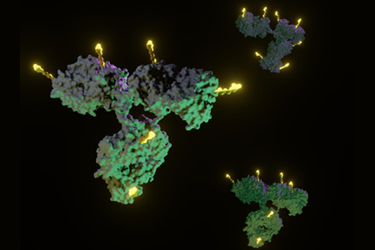How Linker Technology Is Driving ADC Development

By Tyler Menichiello, Chief Editor, Bioprocess Online

If you’re still not excited about antibody drug conjugates (ADC), “there’s an issue with you.” That’s the passionate, bullish sentiment (jokingly) held by Dr. Joe Daccache, project leader at DeciBio, a life science consulting firm focused on precision medicine. “They’re one of the most promising, if not the most promising near-future modalities,” he says.
ADCs can best be summarized as targeted therapies, with some going so far as to call them “magic bullets.” By coupling payloads to cell-targeting antibodies via chemical linkers, ADCs hold a lot of promise — not only for delivering targeted chemotherapies, but for use in immunotherapy, radioimmunotherapy, and even radiology. The design of these chemical linkers is critical to ADC functionality — they determine when and where the payload detaches from the antibody. Fine-tuning these linkers can result in more effective ADCs with less off-target toxicities.
Recently, I had the pleasure of speaking with Daccache about industry advancements in ADC linker technology. He enthusiastically explained the many ways that linker technology has improved, the most significant perhaps being linkers designed to cleave (release payload) at specific sites or under certain conditions, and the variety of applications these advancements can offer. As he puts it, “linker technology is what’s really pushing the ADC field forward — even more so than just the payload itself.” Biotech companies are seeing a lot of opportunities licensing linker platforms.
Site-Specific Cleavage Is The Focus
For a while, progress in the ADC field was slow. Linkers were predominantly enzyme-cleavable, and “there was nothing proprietary about them.” There was nothing stopping other companies from using the same linker. This homogeneity kept investors out, which further stunted innovation in the field. What these early linkers lacked was specificity.
“A shift happened when companies like Mersana and Synaffix created their own patented platform technologies,” Daccache says. A problem with earlier linkers was their instability — they would cleave everywhere. This indiscriminate release of payload led to a lot of off-target toxicities and side effects. Because of this, a lot of older ADCs failed.
While there is not a single “best” linker, designing the optimal linker is a balancing act between making sure it’s stable enough to avoid premature payload release, while also being cleavable enough to deliver at the target site. What companies are doing now is making linkers with pH-dependent or microenvironment-dependent cleavage. These kinds of linkers allow for ADCs that release their payload inside cells, e.g., in the lysosome (hydrazone is an example of a pH-sensitive linker).
This wave of innovation has sparked commercial interest in linkers. Some biotechs’ entire pipelines are centered around designing and licensing linker platforms (e.g., Synaffix). Daccache says investors who previously didn’t see advantages in ADC linker technology, as well as big biopharma companies with no patented linker technologies of their own, are now coming to him with renewed interest. “They’re seeing all these new platforms come online,” he says. “What we’re doing for them is ranking who they should target, and why.” He says one of the most significant factors in this ranking by far is the IP surrounding the linkers.
To Cleave, Or Not To Cleave
While designing linkers that cleave with specificity is a large focus, there are certain instances and payloads where non-cleavable linkers are ideal. “If you’re thinking of something like a radioisotope, you don’t want it to go anywhere,” Daccache explains. Radiolabeled antibodies can be used for things like PET imaging or for radioimmunotherapy. In cases where you’re trying to image or irradiate tumors, non-cleavable linkers prevent the radioisotope from dissipating off target, which allows for more precise imaging and local radiotherapy.
Another class of molecules Daccache mentions is antibody immunostimulatory conjugates (AICs). Instead of a cytotoxic drug payload, immunostimulants and immunomodulators are attached to tumor- or tissue-targeting antibodies, mainly via non-cleavable linkers. Using non-cleavable linkers localizes the immune response to the tumor or tissue site, which prevents the payload from dissipating and triggering wide-spread inflammation or immune suppression.
Whether you’re designing ADCs with a linker that cleaves under specific conditions or with a non-cleavable linker to target an immune response, “nothing can be done without linker advancements.” Daccache is rightfully excited about how innovations in linker technology are pushing the field forward, and he maintains that big things are to come as we continue the journey in optimizing ADCs through improved linkers.
